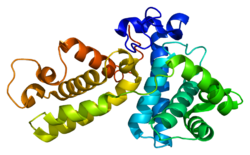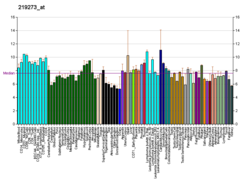Cyclin-K is a protein that in humans is encoded by the CCNK gene.[5][6][7]
Function
The protein encoded by this gene is a member of the transcription cyclin family. These cyclins may regulate transcription through their association with and activation of cyclin-dependent kinases (CDKs) through conformational changes.[8][9] Activation of CDKs through their cyclin partner, creates kinase complexes that will activate target proteins through phosphorylation. Targeted proteins can then ultimately regulate decisions of a cell's progression within the cell cycle to occur. This gene product may be seen to play a dual role in both regulating CDK and RNA polymerase II (RNAP2) activities.[7] Cyclin K only uses RNA recruitment to activate transcription.[10]
Interactions
Cyclin K has been shown to interact with multiple CDKs including CDK9 and latest CDK12 and CDK13.[6][9] Roles include helping to phosphorylate C-terminal domains of subunits of RNAP2.[11] Cyclin K is most noted for its associated induction of processive elongation.[8] Also, identified with G1 and S phase cyclin activity, however functions are not deeply understood.[5][12]
Cyclin K also interacts with HIV nef protein.[13] In the presence of overexpressed Nef protein, Cyclin k and CDK9 binding is induced, inhibiting the positive elongation factor of other CDK9 binding complexes, resulting in an inhibition of specific HIV-1 gene expression.[9][13] CDK 13 may also be characterized to interact with HIV mRNA splicing, alongside Nef, and the underexpression of Gag and Env related proteins.[12][10]
Cyclin K is indispensable for Leukemia growth. SETD1A, is also known to bind Cyclin K through its FLOS domain.[14] The interaction is shown to be important to DNA damage response genes and for Leukemia proliferation.[10][14]
References
- ^ a b c GRCh38: Ensembl release 89: ENSG00000090061 - Ensembl, May 2017
- ^ a b c GRCm38: Ensembl release 89: ENSMUSG00000021258 - Ensembl, May 2017
- ^ "Human PubMed Reference:". National Center for Biotechnology Information, U.S. National Library of Medicine.
- ^ "Mouse PubMed Reference:". National Center for Biotechnology Information, U.S. National Library of Medicine.
- ^ a b Edwards MC, Wong C, Elledge SJ (July 1998). "Human cyclin K, a novel RNA polymerase II-associated cyclin possessing both carboxy-terminal domain kinase and Cdk-activating kinase activity". Molecular and Cellular Biology. 18 (7): 4291–300. doi:10.1128/MCB.18.7.4291. PMC 109013. PMID 9632813.
- ^ a b Fu TJ, Peng J, Lee G, Price DH, Flores O (December 1999). "Cyclin K functions as a CDK9 regulatory subunit and participates in RNA polymerase II transcription". The Journal of Biological Chemistry. 274 (49): 34527–30. doi:10.1074/jbc.274.49.34527. PMID 10574912.
- ^ a b "Entrez Gene: CCNK cyclin K".
- ^ a b Baek K, Brown RS, Birrane G, Ladias JA (February 2007). "Crystal structure of human cyclin K, a positive regulator of cyclin-dependent kinase 9". Journal of Molecular Biology. 366 (2): 563–73. doi:10.1016/j.jmb.2006.11.057. PMC 1852425. PMID 17169370.
- ^ a b c Greifenberg AK, Hönig D, Pilarova K, Düster R, Bartholomeeusen K, Bösken CA, Anand K, Blazek D, Geyer M (January 2016). "Structural and Functional Analysis of the Cdk13/Cyclin K Complex". Cell Reports. 14 (2): 320–31. doi:10.1016/j.celrep.2015.12.025. hdl:11858/00-001M-0000-0029-567D-5. PMID 26748711.
- ^ a b c Kohoutek J, Blazek D (April 2012). "Cyclin K goes with Cdk12 and Cdk13". Cell Division. 7: 12. doi:10.1186/1747-1028-7-12. PMC 3348076. PMID 22512864.
- ^ Edwards MC, Wong C, Elledge SJ (July 1998). "Human cyclin K, a novel RNA polymerase II-associated cyclin possessing both carboxy-terminal domain kinase and Cdk-activating kinase activity". Molecular and Cellular Biology. 18 (7): 4291–300. doi:10.1128/mcb.18.7.4291. PMC 109013. PMID 9632813.
- ^ a b Berro R, Pedati C, Kehn-Hall K, Wu W, Klase Z, Even Y, Genevière AM, Ammosova T, Nekhai S, Kashanchi F (July 2008). "CDK13, a new potential human immunodeficiency virus type 1 inhibitory factor regulating viral mRNA splicing". Journal of Virology. 82 (14): 7155–66. doi:10.1128/JVI.02543-07. PMC 2446983. PMID 18480452.
- ^ a b Khan SZ, Mitra D (July 2011). "Cyclin K inhibits HIV-1 gene expression and replication by interfering with cyclin-dependent kinase 9 (CDK9)-cyclin T1 interaction in Nef-dependent manner". The Journal of Biological Chemistry. 286 (26): 22943–54. doi:10.1074/jbc.M110.201194. PMC 3123062. PMID 21555514.
- ^ a b Hoshii T, Cifani P, Feng Z, Huang CH, Koche R, Chen CW, Delaney CD, Lowe SW, Kentsis A, Armstrong SA (February 2018). "A Non-catalytic Function of SETD1A Regulates Cyclin K and the DNA Damage Response". Cell. 172 (5): 1007–1021.e17. doi:10.1016/j.cell.2018.01.032. PMC 6052445. PMID 29474905.
Further reading
- Lin X, Taube R, Fujinaga K, Peterlin BM (May 2002). "P-TEFb containing cyclin K and Cdk9 can activate transcription via RNA". The Journal of Biological Chemistry. 277 (19): 16873–8. doi:10.1074/jbc.M200117200. PMID 11884399.
- Mori T, Anazawa Y, Matsui K, Fukuda S, Nakamura Y, Arakawa H (2002). "Cyclin K as a direct transcriptional target of the p53 tumor suppressor". Neoplasia. 4 (3): 268–74. doi:10.1038/sj.neo.7900235. PMC 1531701. PMID 11988847.
- Beausoleil SA, Jedrychowski M, Schwartz D, Elias JE, Villén J, Li J, Cohn MA, Cantley LC, Gygi SP (August 2004). "Large-scale characterization of HeLa cell nuclear phosphoproteins". Proceedings of the National Academy of Sciences of the United States of America. 101 (33): 12130–5. Bibcode:2004PNAS..10112130B. doi:10.1073/pnas.0404720101. PMC 514446. PMID 15302935.
- Lim J, Hao T, Shaw C, Patel AJ, Szabó G, Rual JF, Fisk CJ, Li N, Smolyar A, Hill DE, Barabási AL, Vidal M, Zoghbi HY (May 2006). "A protein-protein interaction network for human inherited ataxias and disorders of Purkinje cell degeneration". Cell. 125 (4): 801–14. doi:10.1016/j.cell.2006.03.032. PMID 16713569.
- Olsen JV, Blagoev B, Gnad F, Macek B, Kumar C, Mortensen P, Mann M (November 2006). "Global, in vivo, and site-specific phosphorylation dynamics in signaling networks". Cell. 127 (3): 635–48. doi:10.1016/j.cell.2006.09.026. PMID 17081983.
- Baek K, Brown RS, Birrane G, Ladias JA (February 2007). "Crystal structure of human cyclin K, a positive regulator of cyclin-dependent kinase 9". Journal of Molecular Biology. 366 (2): 563–73. doi:10.1016/j.jmb.2006.11.057. PMC 1852425. PMID 17169370.
External links
- Overview of all the structural information available in the PDB for UniProt: O75909 (Cyclin-K) at the PDBe-KB.







